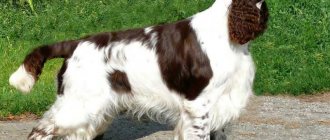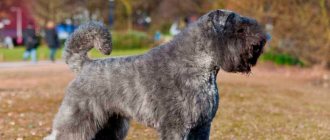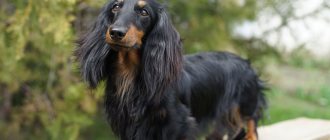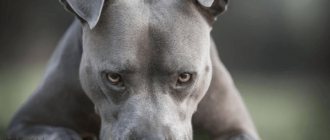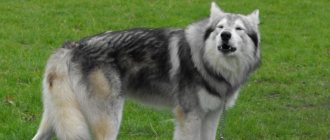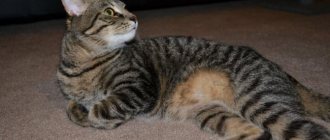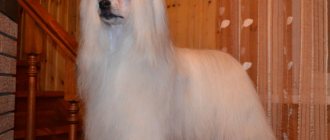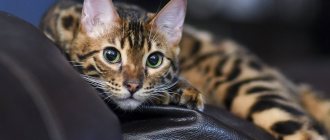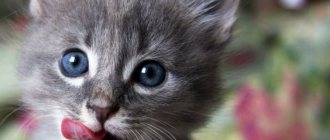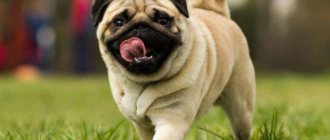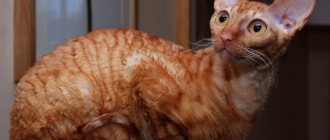History of the breed
The Cirneco dell'Etna is a very ancient breed, living in Sicily for hundreds or thousands of years. It is similar to other breeds native to the Mediterranean: the Pharaoh Hound of Malta, the Ibicenco Podenco and the Canario Podenco.
These breeds are distinguished by their primitive appearance, all native to the Mediterranean islands and specialized in hunting rabbits.
It is believed that Cirneco del Etna comes from the Middle East. Most linguists believe that the word Cirneko comes from the Greek “Kyrenaikos”, the ancient name of the Syrian city of Shahhat.
Cyrene was the oldest and most influential Greek colony in Eastern Libya and was so important that the entire region is still called Cyrenaica. It is believed that at first the dogs were called Cane Cirenaico - a dog from Cyrenaica.
This indicates that dogs came to Sicily from North Africa, along with Greek merchants.
The first written use of the word Cirneco appears in a Sicilian law from 1533. He limited hunting with these dogs, as they caused great damage to the prey.
There's just one big problem with the evidence base for this theory. Cyrene was founded later than these dogs appeared. Coins dating back to the 5th century BC show dogs almost identical to the modern Cirneco dell'Etna.
It is likely that they came to Sicily earlier and were then mistakenly associated with this city, but it may be that they are an indigenous breed. Recent genetic studies have revealed that the Pharaoh Hound and the Ibicenco Podenco are not so closely related.
Moreover, these greyhounds did not descend from one ancestor, but developed independently of each other. It is possible that Cirneco dell'Etna emerged through natural selection, but also that the genetic tests are flawed.
We will never know exactly how it appeared, but the fact that it was highly valued by local residents is a fact. As mentioned, these dogs were regularly depicted on coins issued between the 3rd and 5th centuries BC. e.
On one side they depict the god Adranos, the Sicilian personification of Mount Etna, and on the other a dog. This means that 2500 years ago they were associated with a volcano, which gave the rock its modern name.
Legend has it that Dionysus, the god of wine and fun, founded a temple on the slope of Etna around 400 BC, near the city of Adrano. Dogs were bred in the temple to serve as guards within the temple, and at one point there were about 1,000 of them. The dogs had a divine ability to identify thieves and non-believers, whom they immediately attacked. They found lost pilgrims and escorted them to the temple.
According to legend, Cirneco was especially disposed towards drunken pilgrims, since most of the holidays dedicated to this god took place with copious libations.
The breed remained a native hunting breed for hundreds of years, even after its religious significance disappeared with the advent of Christianity. Images of these dogs can be found on many Roman artifacts.
They were distributed throughout Sicily, but especially in the region of Mount Etna. The main object of hunting for them was rabbits, although they could hunt other animals.
The Romans began a policy of deliberately cutting down forests to make room for crops, which they continued after them.
Large mammals disappeared as a result of this; the only animals available for hunting were rabbits and foxes. Hunting rabbits was an extremely important activity for Sicilian peasants, since, on the one hand, they destroyed crops, and on the other, they served as an important source of protein.
If throughout Europe keeping dogs was the lot of the aristocracy, then in Sicily they were kept by peasants. They were an important part of their lives, but they fell on hard times at the beginning of the 20th century.
Technology and urbanization meant that the need for dogs decreased and few could afford them. Moreover, besides the island, Cirneco dell'Etna was not popular anywhere, even in mainland Italy. In 1932, Dr. Maurizio Migneco, a veterinarian from Andrano, wrote an article for the magazine “Italian Hunter” (Cacciatore Italiano), where he described the deplorable state of the ancient breed.
Several very influential Sicilians joined forces to save the breed. They were joined by Baroness Agata Paterno Castelo, better known as Donna Agata.
She will devote the next 26 years of her life to this breed, study its history, and find the best representatives. She will collect these representatives in her nursery and begin methodical breeding work.
When Cirneco is restored, she will turn to the famous zoologist, Professor Giuseppe Solano. Professor Solano would study canine anatomy, behavior and publish the first breed standard in 1938. The Italian Kennel Club recognizes it instantly, since the breed is clearly older than most native Italian dogs.
In 1951, the first club for fans of this breed was founded in Catania. The Fédération Cynologique Internationale recognized the breed in 1989, which generated interest in it outside of Italy.
Unfortunately, she is still little known outside her homeland, although she has her fans in Russia.
The Cirneco dell'Etna is similar to other Mediterranean greyhounds, such as the Pharaoh Hound, but smaller. These are medium-sized dogs, graceful and elegant.
Males at the withers reach 46–52 cm and weigh 10–12 kg, females 42–50 and 8–10 kg. Like most greyhounds, she is very thin, but does not look emaciated like the same Azawakh.
DESCRIPTION
The Cirneco dell'Etna is similar to other Mediterranean greyhounds, such as the Pharaoh Hound, but smaller. These are medium-sized dogs, graceful and elegant. Males at the withers reach 46–52 cm and weigh 10–12 kg, females 42–50 and 8–10 kg. Like most greyhounds, she is very thin, but does not look emaciated like the same Azawakh.
The head is narrow, 80% of its length is the muzzle, the stop is very smooth. The nose is large, square, its color depends on the color of the coat. The eyes are very small, ocher or gray in color, not brown or dark hazel. The ears are very large, especially in length. Standing, rigid, they are triangular in shape with narrow tips.
The Cirneco dell'Etna's coat is very short, especially on the head, ears and paws. On the body and tail it is slightly longer and reaches 2.5 cm. It is straight, hard, reminiscent of horse hair. Cirneco del Etna is almost always the same color - fawn. White markings on the head, chest, tip of the tail, paws and belly are acceptable, but may not be present. Sometimes dogs are born completely white or white with red spots. They are acceptable, but not particularly encouraged.
a brief description of
- Other names: Sicilian Hound, Cirneco dell'Etna, Sicilian Greyhound, Sicilian Greyhound, Sicilian.
- Height: 46.0-50.0 cm.
- Weight: 10-12 kg.
- Color: red, even, rich. Let's say white and white with red tan. All shades of fawn and all shades of ocher are allowed.
- Coat: short, no longer than 3.0 cm, smooth, lying close to the body.
- Life expectancy: 12-15 years.
- Advantages of the breed: easy to train, unpretentious dogs. They have an affectionate and affectionate character. Their temperaments are typical hunters. The family has cheerful, loving and very active dogs, right up to old age.
- Difficulties: hard to tolerate cold, and especially dampness. Dogs need to be warmed in winter. The animal's claws require careful attention and should be trimmed promptly.
- Price: $950.
Appearance
The Cirneco del Etna dog breed is indigenous , that is, it occurred as a result of natural selection and formation. Females and males differ slightly. Regardless of gender, dogs are characterized by a square body type and harmony. The description of the breed also applies to the boundaries in the size of the dogs:
- Males - optimal height at the withers is 46–50 or 52 cm; weight 10–12 kg.
- Bitches – optimal height at the withers is 42–46 or 50 cm; weight 8–10 kg.
The Cirneco del Etna is an animal with wild roots, whose mission is difficult hunting and each representative of the breed, regardless of gender and age, must demonstrate strength and agility. Dogs are characterized by a lively and very lively temperament, but in relation to their owners, the four-legged dogs are very flexible and loyal.
Aboriginal breeds are special, they are all a little similar and at the same time different. If we consider the Sicilian Greyhounds, we can name two very similar breeds: the Basenji and the Pharaoh Hound. Let's name the main differences:
- Sicilian Greyhound : dimensions 45–52 cm and 8–12 kg; color – uniform red; coat type – short, thin; homeland - Sicily.
- Pharaoh Hound : dimensions 53–63.5 cm and 18–27 kg; color – uniform red with or without white spots; coat type – dense, short; homeland unknown, probably Malta.
- Basenji : dimensions 40–43 cm and 9.5–11 kg; color - tricolor, bicolor, brindle, speckled; coat type – short, medium length, dense; homeland - Egypt.
As you can see, the differences between the Cirneco dell'Etna and the Pharaoh's Hound are obvious, although they are very similar in appearance. It is more difficult to confuse the Sicilian Greyhound with the Basenji due to the difference in colors.
Origin story
The first information about the existence of elegant dogs with the musical-sounding name Cirneco dell'Etna was recorded as a result of archaeological excavations in the area at the foot of the Sicilian volcano Etna. Hence the prefix to the name of the breed.
According to scientists, the breed dates back at least two and a half thousand years , and belongs to the aboriginal dogs of the island of Sicily. According to recent research, which was based on genetic analysis, animals in Sicily appeared thanks to the ancient Egyptians, who developed the surrounding territories.
Scientists have noticed that the images of animals on the sarcophagi and tombs of the ancient Egyptian pharaohs are very similar to the modern phenotype of these dogs - beautiful and elegant with long, gracefully upward-pointing ears.
Even the Egyptian god of the underworld, Anubis, has similarities with the features of the pointy-eared Sicilian greyhound. Therefore, we can safely make the assumption that the age of the breed is much older than official information is presented to us.
Other Italian dogs that are close to this phenotype are the Pharaoh Hound and the Ibicenco Podenco, which are just as elegant and evenly colored, but differ from the Cirneco dell’Etna in a much larger size. It can be assumed that all of the above Italian dogs had common ancestors.
Purpose of the breed
There are two unofficial modern varieties of the Sicilian Greyhound breed:
- type of northern Cirneco dell'Etna.
Both types differ in body proportions and different lengths of limbs. But this factor was not reflected in the description of the breed standard adopted by the FCI. Leg length no small importance only for dogs working in the Sicilian landscape - mountainous in the north and flat rocky in the south of the country and at the foot of a volcano. Greyhounds are still used for their intended purpose. They participate in traditional rabbit hunting.
Over the past fifty years, animals have been bred exclusively for sporting competitions. Also, field trials are often held for breeding dogs, where the Cirneco dell'Etna can show itself in all its glory.
The third purpose of the modern Sicilian is a companion dog. Obedient, intelligent, extremely sensual dogs often become prize-winners in dog shows held around the world. Sicilian greyhounds also take part in coursing competitions, or simulated hare-catching races, and agility.
Sicilian greyhounds are considered unsurpassed hunters. Their energetic temperament is surprisingly combined with peacefulness and complaisance . In general, the Cirneco del Etna can be described as a playful, affectionate, cheerful breed with a very affectionate and devoted character.
The animal is distinguished by its inquisitiveness and immense curiosity. A priori, they have no sense of dominance, since dogs do not lead a pack lifestyle.
They are wary of strangers, but get along well with animals. If training is directed in the right direction, the Sicilian Greyhound will make a good guard and an intelligent watchman.
Representatives of this breed do not like to be intrusive and rarely speak out . These are great companion dogs. They are happy to accompany their owners on trips, long walks or bike rides, proudly walking alongside them, as they are very hardy dogs.
Choosing a puppy
According to the unspoken but generally accepted rules for choosing a puppy, you should adhere to the basic principle. Of all the strong, active and playful puppies in the litter, you should choose the average one , not the large one, or vice versa, the quietest and smallest dog child.
The puppy should not have any signs of rickets. If the stomach is swollen and it is not rickets, you should ask when the puppies were last dewormed, and immediately deworm them upon arrival home.
At two months, puppies look the same as they will look as adults. At eight weeks you can see a miniature copy of an adult dog . Therefore, it is highly desirable to have a visual acquaintance with the parents of the litter, where you can carefully examine both the mother and the father of the glorious family.
The puppy you have chosen must have the following documents:
- birth certificate certified by the breed club;
- veterinary passport, which contains the dates of vaccinations, according to the age of the baby;
- an implanted chip or brand, or possibly both;
- pedigrees of mother and father;
- parental health certificates.
As a rule, the breeder provides detailed recommendations on raising and feeding the puppy in writing, and leaves his contact details so that the new owner can contact him without delay in emergency or unusual cases.
Nicknames and names
All pedigree puppies have nicknames, and their new owners assign pet names to them. Names do not appear in breeding records, and are used by the owner at the everyday level.
Popular nicknames for dogs of the Sicilian Greyhound breed are, as a rule, Italian concepts and definitions, as well as geographical names of places:
- males - Are, Lyman, Wacker, Hesper, Kato, Vaiden, Borat;
- females – Nelda, Lima, Nicey, Jassy, Verity, Brigita, Dixa, Bessie.
Care and maintenance
The Sicilian Greyhound is quite unpretentious in its maintenance. It is enough to comb it once a week with a special brush with stiff bristles. These are very clean animals, and also odorless. Dogs are bathed extremely rarely - even for those who participate in exhibitions, bathing with special means is provided no more than once a month.
The ears of the Cirneco dell'Etna require a lot of attention. Dogs should have their ears cleaned regularly, as accumulated secretions can cause inflammation of the middle ear. The dog's nails need even more attention and need to be trimmed regularly. Animals of the light weight category do not wear them down well during a walk, and the length of the claws is of particular importance in the life of the dog, especially in puppyhood. Long claws not only lead to changes in gait, but also cause improper formation of the joints of the limbs during the growth and development of the dog.
Sicilians do not tolerate dampness well and absolutely do not tolerate rainy weather. They swim happily, but the water dripping from above puts them in a depressed state.
Animals are afraid of dampness, frost and drafts. Therefore, a place is arranged for them in the warmest corner of the house. After an hour or an hour and a half, if the dog was walked in pouring rain or on a frosty day, it should measure its body temperature to avoid colds in the pet.
Health and heredity
Veterinarians classify this ancient Sicilian breed as one of the healthiest representatives of the canine world. Moreover, dogs do not suffer from heredity or predisposition to certain diseases.
But dogs need seasonal treatments against blood-sucking parasites - fleas, mosquitoes and ticks, carriers of severe infectious diseases. Preventive measures are also necessary to expel worms from the digestive tract. Not only pets, but also their owners need regular deworming.
Advantages and disadvantages
Dogs of the Cirneco dell'Etna breed are extremely intelligent. The exterior shows the unsurpassed harmony of these graceful dogs with the appearance of an emperor. Animals are obedient and accommodating. Moreover, they are very insightful and, as they say, see right through the owner, always guessing the owner's desire.
Dogs do not have an undercoat, so the animals have no odor and are considered hypoallergenic dogs. And secondly, they have difficulty withstanding the cold season unless they are dressed in a blanket, jacket or special sweater.
Dogs of this breed are not suitable for every owner. A beautiful and spectacular animal is far from a glamor model. These dogs are contraindicated for people leading a sedentary lifestyle. While still a puppy, breeders recommend not accustoming the dog to a diaper or litter box, so that the dog gets used to going to the toilet outside from the first days.
Among all the Mediterranean dog breeds, the Sicilian Greyhound has amazing abilities and is easy to train. On the other hand, dogs are capricious and have their own opinions. Sometimes they become disobedient, refusing to carry out even the most primitive commands of the owner. And this can only happen because the dog was treated unfairly or was offended in some way.
Our pet is only three months old, but he is a born athlete. Not once did he lag behind me on a bike ride. He always runs alongside and can keep the pace for a long time, and this is at three months! Passionately loves fruits, and most of all apples.
This breed was created for me, with my restless character. And it’s good that I took the boy. True, I had to suffer a little with his upbringing, but now he is just a calm and surprisingly obedient dog, who will not take a step without my order.
Attitude towards children and pets
Although the Cirneco is a dog breed bred for hunting, it gets along well with children. Together they will come up with many fun games and will never get bored.
Cirnecos also get along with other dogs, especially if they grow up together. But conflicts are possible with newly arrived pets - after all, these natives of Sicily are distinguished by jealousy.
Gorgeous litter of puppies
Features of the breed and character of the dog
The origin and formation of the Cirneco dell'Etna breed took place on the island of Sicily, near the famous volcano, the name of which was reflected in the name of the dogs. The confinement of the territory helped to limit crossing with other quadrupeds and preserve the main characteristics of the breed.
Peculiarities of the environment, prolonged inbreeding, and lack of food have shaped the animal’s miniature size and graceful forms, but they have nothing to do with ornamental breeds.
External thinness does not give the impression of exhaustion. The dog's small eyes and very large triangular ears are notable. The fawn coat is short, especially on the limbs and head, and has a rough, hard texture.
The Cirneco del Etna dog is exclusively domestic, although it has an active disposition. She has natural energy and independence. The behavior of the dogs is friendly, they communicate well with people, and show affection for their owners.
In families, they will always give preference to one person, but maintain an equal attitude towards other family members and their friends. They do not like unnecessary fuss and are not inclined to express emotions with loud barking. They know their territory and are jealous of strangers. They like to alternate activities and do not tolerate loneliness.
Sicilian dogs were originally bred to hunt hares, but they can also handle other small animals. In thousands of years of history, Cherneko's hunting instinct has been strengthened, so they are ready to pursue all living things that they can.
Does not tolerate boredom, as it is a working dog. Cerneco del Etna loves active games, walks, traveling with family members, children and faithfully serves his owners.
They can sincerely make friends with other four-legged animals in the house, but they do not tolerate rodents nearby. Proper training encourages them to put up with an indoor cat, but keeping a dog from chasing them outside can be difficult.
The dog is the most trainable among all Mediterranean greyhounds. You can buy a Cirneco del Etna dog for an athletic person who leads an on-the-go lifestyle.
They prefer affection through affection, persuasion and treats. They do not tolerate manifestations of rudeness and force. In pursuit they do not accept commands, but training corrects their behavior.
Natural intelligence, learning ability, sensitivity and affection for the owner make them favorites in families. If during walks the dog actively runs, plays, and hunts, then in the apartment it can sleep secluded and not cause disturbances. The strength of the breed is the ability to adapt to the rhythm and habits of the owner, his needs.
Character
If there is no such opportunity, then he suffers greatly from loneliness. Although there is no reliable information about her attitude towards children, it is believed that she treats her very well, especially if she grew up with them.
She has no aggression towards strangers either; they are very friendly and happy to meet new people. They like to express their feelings by jumping and trying to lick; if this is unpleasant for you, you can correct the behavior by training. It is logical that a dog with such a character is not suitable for the role of a guard. They get along well with other dogs, moreover, they prefer their company, especially if it is another Cirneco del Etna. Like other dogs, without proper socialization they can be fearful or aggressive, but such cases are rather the exception.
But they do not find a common language with other animals. The Sicilian Greyhound is designed to hunt small animals, has successfully hunted them for thousands of years, and has an incredibly strong hunting instinct. These dogs chase and kill everything in their power, so a walk can end in disaster. With proper training they are capable of living with a domestic cat, but some never accept them.
The Cirneco dell'Etna is one of the most trainable, if not the most trainable, of the Mediterranean greyhounds. Representatives of the breed performing in agility and obedience perform very well.
They are very intelligent and learn quickly, but are sensitive to training methods. Rudeness and harsh behavior are more likely to scare them away, but a kind word and delicacy will delight them. Like other greyhounds, they do not respond well to commands when chasing an animal. But, compared to others, they are not yet hopeless and are able to stop.
When keeping it in the yard, you need to ensure its complete safety. These dogs are able to crawl into the smallest gap, jump high and dig the ground very well.
Temperament
The Cirneco dell'Etna has an extremely strong and independent character . At the same time, they easily make contact, show friendliness and are attached to their owners. They have a stable psyche and a need for a variety of activities.
This is an exclusively domestic dog , albeit a very energetic one. They like to alternate between playing and sleeping under a warm blanket.
They become attached to all family members, although one will be singled out. However, this point is not expressed as strongly among them as among the Salukis. They are jealous of their territory, but they treat family friends warmly.
This breed is not prone to unnecessary fuss and loud barking . Although they are small in size, they are not toy dogs.
Psyche
Breed experts say that Cirneco dogs are good companions for walking and sports, hunters and even, to some extent, guards. Cirnecos are smart, their psyche is stable, and despite their small size, they are fearless and loyal.
Cirnecos need additional socialization. Natural dogs are fun-loving by nature and in some ways wild and impulsive. They are one of those who, upon meeting, energetically jump on the owner, trying to lick his face. They do not bark much, but they carefully monitor their surroundings. In a busy area it is recommended to keep him on a leash. It is noted that cirnecos take a long time to mature - up to 2 years. It is recommended to socialize pets from an early age and take them with you to public places to strengthen stress resistance and cultivate goodwill towards others.
Cirneco gets along well with children, but is not a nanny dog and does not like to be cuddled too much. They will get along well with other pets if they were raised together. If other animals appear in the house during adulthood, the cirneco may have problems associated with rejection of the new member of the pack. In the house, they mistake the owner for the leader and always follow him. They even prefer to sleep in the owner’s bed - this should also be taken into account when choosing this breed.
Who is the Sicilian dog suitable for?
The Sicilian Greyhound is suitable for apartment living. But it is important that the owner leads an active lifestyle. As practice shows, the breed is ideal for athletes and hunters. The pet should not be left alone at home for an extended period of time.
Note! The dog is friendly, but with the appearance of children in the house, you should not count on its 100% obedience. Pets often become jealous, so breeders recommend holding off on purchasing a dog until your children are older.
In an apartment, the animal gets along with other pets, but on the street at any convenient time it can chase another dog or cat.
Description of the Cirneco del Etna breed (standard requirements)
The dog would not have gained fame outside of Sicily if it were not for Baroness Agata Paterno-Castello, a fan of the breed. Documenting the work on the characteristic features of representatives and their improvement made it possible to develop a standard adopted in 1939 and updated in 1989.
According to the standard description, the Cherneko smooth-haired dog is elegantly built, strong and robust. Proportional elongated lines of the body, limbs, overall appearance of a square format. The beautiful appearance of the animal attracts attention. Height is from 42 to 50 cm, and weight is from 10 to 12 kg. Females are smaller in size compared to males.
The head is elongated with an elongated muzzle and a straight line of the nose. The eyes are small in size, with a soft look, located on the sides. The ears are set close, erect, large, hard, with narrow tips. The lips are thin and compressed. The length of the neck is equal to half the length of the head, with developed muscles and stretched, without dewlap, skin.
The back is straight, the belly line is smooth in accordance with the lean and dry lower body. The length of the sternum is approximately half or slightly more than the height of the dog at the withers.
Legs are straight and muscular. Paws “in a ball”, with brownish or flesh-colored claws. The tail is set low and of even thickness along the length. The shape of a curved saber becomes a “pipe” in a state of excitement.
Short coat color in fawn variations. White markings are allowed. Hair length up to 3 cm is possible only on the tail and body. The head, muzzle and paws are covered with very short hair.
There are some differences in proportions between the types of northern and southern Sicilian dogs, but this is not reflected in the international standard. Temperament is manifested by active movements, playfulness, curiosity, and a thirst for action. But affection is expressed in the ability to expect, communication, and affection.
They bark only when excited or showing a signal of demanding something. Hanging ears, a curled tail, black pigmentation, growth fluctuations of more than 2 cm are signs of a breed defect.
Coat type and color
The FCI (Fédération Cynologique Internationale) breed standard clearly states that the Sicilian Greyhound must be fit. The skin is delicate, thin, without folds throughout the body. Skin pigmentation varies depending on the predominant pigmentation of the coat.
Important! Black spots or specks are unacceptable even on the skin.
The guard hair is smooth, evenly distributed over the body and fine in structure, not too soft. The coat is slightly elongated and soft, but smooth and close-lying, on the head, ears and feet. Representatives of the breed lack an undercoat because they are not adapted to natural living in cold regions. The structure of the spine is quite rigid and extremely smooth. Colors are divided into two types:
- Monochromatic - in a red palette from fawn to light cinnamon. Completely white color is acceptable.
- Bicolor - red-white or white-red, respectively, one of the colors predominates, and the other marks are highlighted. The spots are located on the head, chest, limbs, belly, tip of the tail and a white stripe encircling the neck (optional).
Note! An almost uniform color with a mixture of red and lightened/darkened fur is acceptable.
Care and maintenance
In general, a dog requires the same care as any other. Natural health and the absence of genetic diseases do not create great difficulties in maintenance.
It is recommended to take into account the southern origin of the breed and take care of a warm bed, protected from drafts. In cold weather, you will need warm clothes for your pet. Physical activity promotes a healthy lifestyle and prevents dog obesity. Her appetite is always excellent.
Short hair requires minimal grooming. Regular brushing of the dog, about once a week, is necessary to remove dead hair. Large ears need cleaning to avoid inflammation and otitis media.
the Cerneco del Etna puppy to trimming its nails from an early age, otherwise it will desperately resist. Grinding of claws can be achieved naturally only with systematic exercise and walks in nature.
An independent character requires proper training and a firm hand from the owner. With constant communication, the dog is able to capture even the mood of its companion. Buying a Cerneco del Etna puppy means finding a pet and a companion for family walks for 12-15 years. This is the lifespan of a dog.
Education and training
As soon as the puppy has crossed the threshold of a new home, you should start raising it, immediately socialize it, and train it independently. The dog should be introduced to every dog he meets, a neighbor, an acquaintance, and people he simply meets by chance. In the absence of proper upbringing, a timid neurasthenic may grow up, aggressive towards his relatives, and hopelessly afraid of strangers.
